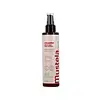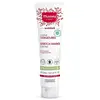What's inside
What's inside
 Key Ingredients
Key Ingredients

No key ingredients
 Benefits
Benefits

 Concerns
Concerns

 Ingredients Side-by-side
Ingredients Side-by-side

Water
Skin ConditioningCaprylic/Capric Triglyceride
MaskingHelianthus Annuus Seed Oil
EmollientGlycerin
HumectantSucrose Stearate
EmollientPassiflora Edulis Seed Oil
EmollientCetearyl Alcohol
EmollientGlyceryl Caprylate
EmollientSodium Stearoyl Glutamate
CleansingGellan Gum
Xanthan Gum
EmulsifyingAloe Barbadensis Leaf Juice Powder
Skin ConditioningSodium Benzoate
MaskingLevulinic Acid
PerfumingPropanediol
SolventSodium Levulinate
Skin ConditioningCitric Acid
BufferingPassiflora Edulis Fruit Extract
Skin ConditioningWater, Caprylic/Capric Triglyceride, Helianthus Annuus Seed Oil, Glycerin, Sucrose Stearate, Passiflora Edulis Seed Oil, Cetearyl Alcohol, Glyceryl Caprylate, Sodium Stearoyl Glutamate, Gellan Gum, Xanthan Gum, Aloe Barbadensis Leaf Juice Powder, Sodium Benzoate, Levulinic Acid, Propanediol, Sodium Levulinate, Citric Acid, Passiflora Edulis Fruit Extract
Water
Skin ConditioningCoco-Caprylate/Caprate
EmollientDicaprylyl Carbonate
EmollientGlycerin
HumectantButyrospermum Parkii Butter
Skin ConditioningC10-18 Triglycerides
EmollientCandelilla/Jojoba/Rice Bran Polyglyceryl-3 Esters
EmulsifyingGlyceryl Stearate
EmollientCetearyl Alcohol
EmollientSodium Stearoyl Lactylate
Emulsifying1,2-Hexanediol
Skin ConditioningPersea Gratissima Oil
Skin ConditioningPolyacrylate Crosspolymer-6
Emulsion StabilisingTocopherol
AntioxidantCaprylyl Glycol
EmollientSodium Stearoyl Glutamate
CleansingPropanediol
SolventCitric Acid
BufferingHydrolyzed Avocado Protein
Skin ConditioningMaltodextrin
AbsorbentPentylene Glycol
Skin ConditioningSodium Hydroxide
BufferingHamamelis Virginiana Leaf Extract
Skin ConditioningXanthan Gum
EmulsifyingPassiflora Edulis Fruit Extract
Skin ConditioningWater, Coco-Caprylate/Caprate, Dicaprylyl Carbonate, Glycerin, Butyrospermum Parkii Butter, C10-18 Triglycerides, Candelilla/Jojoba/Rice Bran Polyglyceryl-3 Esters, Glyceryl Stearate, Cetearyl Alcohol, Sodium Stearoyl Lactylate, 1,2-Hexanediol, Persea Gratissima Oil, Polyacrylate Crosspolymer-6, Tocopherol, Caprylyl Glycol, Sodium Stearoyl Glutamate, Propanediol, Citric Acid, Hydrolyzed Avocado Protein, Maltodextrin, Pentylene Glycol, Sodium Hydroxide, Hamamelis Virginiana Leaf Extract, Xanthan Gum, Passiflora Edulis Fruit Extract
Ingredients Explained
These ingredients are found in both products.
Ingredients higher up in an ingredient list are typically present in a larger amount.
Cetearyl alcohol is a mixture of two fatty alcohols: cetyl alcohol and stearyl alcohol. It is mainly used as an emulsifier. Emulsifiers help prevent the separation of oils and products. Due to its composition, it can also be used to thicken a product or help create foam.
Cetearyl alcohol is an emollient. Emollients help soothe and hydrate the skin by trapping moisture.
Studies show Cetearyl alcohol is non-toxic and non-irritating. The FDA allows products labeled "alcohol-free" to have fatty alcohols.
This ingredient is usually derived from plant oils such as palm, vegetable, or coconut oils. There is debate on whether this ingredient will cause acne.
Due to the fatty acid base, this ingredient may not be Malassezia folliculitis safe.
Learn more about Cetearyl AlcoholCitric Acid is an alpha hydroxy acid (AHA) naturally found in citrus fruits like oranges, lemons, and limes.
Like other AHAs, citric acid can exfoliate skin by breaking down the bonds that hold dead skin cells together. This helps reveal smoother and brighter skin underneath.
However, this exfoliating effect only happens at high concentrations (20%) which can be hard to find in cosmetic products.
Due to this, citric acid is usually included in small amounts as a pH adjuster. This helps keep products slightly more acidic and compatible with skin's natural pH.
In skincare formulas, citric acid can:
While it can provide some skin benefits, research shows lactic acid and glycolic acid are generally more effective and less irritating exfoliants.
Most citric acid used in skincare today is made by fermenting sugars (usually from molasses). This synthetic version is identical to the natural citrus form but easier to stabilize and use in formulations.
Read more about some other popular AHA's here:
Learn more about Citric AcidGlycerin is already naturally found in your skin. It helps moisturize and protect your skin.
A study from 2016 found glycerin to be more effective as a humectant than AHAs and hyaluronic acid.
As a humectant, it helps the skin stay hydrated by pulling moisture to your skin. The low molecular weight of glycerin allows it to pull moisture into the deeper layers of your skin.
Hydrated skin improves your skin barrier; Your skin barrier helps protect against irritants and bacteria.
Glycerin has also been found to have antimicrobial and antiviral properties. Due to these properties, glycerin is often used in wound and burn treatments.
In cosmetics, glycerin is usually derived from plants such as soybean or palm. However, it can also be sourced from animals, such as tallow or animal fat.
This ingredient is organic, colorless, odorless, and non-toxic.
Glycerin is the name for this ingredient in American English. British English uses Glycerol/Glycerine.
Learn more about GlycerinWe don't have a description for Passiflora Edulis Fruit Extract yet.
Propanediol is an all-star ingredient. It softens, hydrates, and smooths the skin.
It’s often used to:
Propanediol is not likely to cause sensitivity and considered safe to use. It is derived from corn or petroleum with a clear color and no scent.
Learn more about PropanediolSodium Stearoyl Glutamate is an emulsifier and helps condition the skin. It is amino acid-based.
In higher amounts, it may act as a cleansing agent.
Water. It's the most common cosmetic ingredient of all. You'll usually see it at the top of ingredient lists, meaning that it makes up the largest part of the product.
So why is it so popular? Water most often acts as a solvent - this means that it helps dissolve other ingredients into the formulation.
You'll also recognize water as that liquid we all need to stay alive. If you see this, drink a glass of water. Stay hydrated!
Learn more about WaterXanthan gum is used as a stabilizer and thickener within cosmetic products. It helps give products a sticky, thick feeling - preventing them from being too runny.
On the technical side of things, xanthan gum is a polysaccharide - a combination consisting of multiple sugar molecules bonded together.
Xanthan gum is a pretty common and great ingredient. It is a natural, non-toxic, non-irritating ingredient that is also commonly used in food products.
Learn more about Xanthan Gum